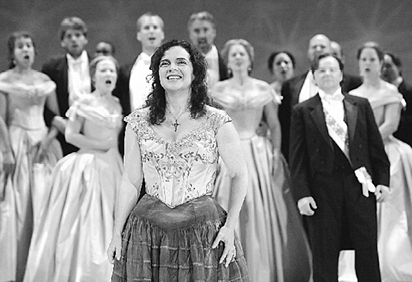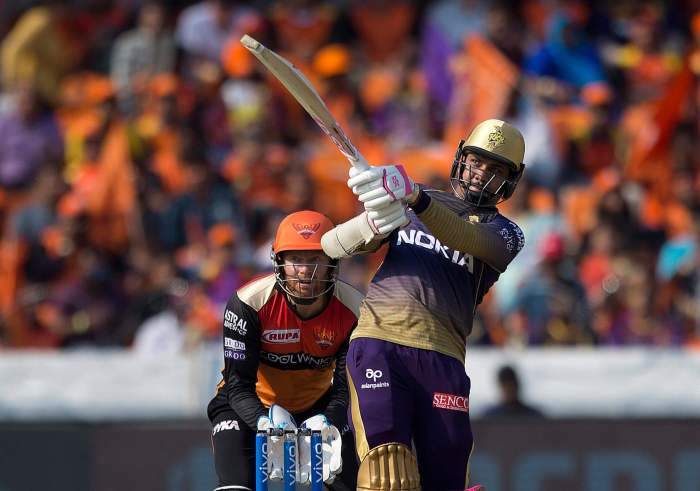Minnesota Opera brings rarities to the fore
Minnesota Opera’s ongoing engagement with neglected bel canto repertory brought opera-goers from both coasts to see their season-opening “La donna del lago” September 23. Minnesota audiences were rewarded with a generally enjoyable performance distinguished by the excellent Rossinian vocalism of the four principals. Malcom was Ewa Podles’ local stage debut. In magnificent form, she received a vociferous welcome for her richly expressive and technically astonishing bravura. She brought the evening to its highest plane, offering truly heroic coloratura singing.
Maureen O’Flynn (Elena) was extremely brave to perform at all; she had endured an emergency appendectomy just two weeks before, and visibly used a hand to support her diaphragm muscles. Her lower voice is never the strongest suit of this appealing soprano, but her voice soars to limpid beauty at the top, and she made a satisfying heroine. At her considerable best in ensembles, she over-decorated her final rondo.
With remarkable flexibility and confidence on high and dramatic panache, Barry Banks fared exceptionally well as the disguised King. Less persuasive an actor, slightly unpredictable in musical and linguistic detail, Yegishe Manuchuryan (Rodrigo) still must be accounted a major Rossini talent—he did justice to the part’s multi-octave leaps; the trio in which he, Banks and O’Flynn tossed off multiple high C’s won cheers.
The company’s spare, non-figurative house bel canto style yielded serviceable, darkly industrial sets from David Zinn better suited to “Flying Dutchman.” No lake, only one dead, blasted tree, falling snow—could not the production team hear the verdant rusticity implicit in the music (and quite explicit in the libretto!)? This static narrative needs an enfolding element of the picturesque.
The performance under Robert Wood displayed an orchestra and chorus in good shape achieving satisfying ensemble, though Wood’s pacing could be erratic. The generally responsible edition chosen added a fine quartet from “Bianca e Falliero.” Recitative was cut, sometimes heedlessly—Elena spoke of asking the King to spare Rodrigo’s life, but five minutes later the crucial lines in which she does so and learns that he is dead had vanished.
This can be rethought before “Donna del lago” moves to NYCO in April with another formidable lineup—Banks, supercharged diva Alexandrina Pendtachanska, plus the wonderful Laura Vlasak Nolen and Daniel Mobbs. City Opera revived one of its signature pieces, the Frank Corsaro-helmed, slide and video-driven 1975 “Die tote Stadt.” It evokes its era—the videos look like outtakes from “Shadows of Forgotten Ancestors”—but holds up quite well, making an intriguing case for Korngold’s musically derivative but fascinating opera.
Susan B. Anthony performed valiantly through a cold, giving Marietta credible personality and allure—and dancing rather well; occasionally her voice freed itself and showed what she could do in the role’s soaring lines. The stumbling block in casting this show is that the lead tenor role, Paul, is a voice-destroyer, unless you have someone utterly secure in high placement, like John Alexander, the 1975 hero.
Canadian tenor Dan Chamandy must be useful in the small European houses he frequents; he had the notes and got through the part, but with minimal tonal allure. The provincial Fabio locks he sported more summoned up a greyhound track in contemporary Alberta than Bruges in 1895. Two fine baritones sang Frank and Fritz—Weston Hurt and Keith Phares—the latter charming if not as floatily rapturous as some in “Pierrots Tanzlied.”
George Manahan led supportively. City Opera should scour the world for Pauls and keep this “Tote Stadt” alive. Baltimore Opera made the irresponsible decision to fly in the face of decades of Rossini scholarship and use, with some toning down of prima donna frippery, the utterly corrupt edition Thomas Schippers made of “L’assedio di Corinto” for Beverly Sills at La Scala (1969) and the Met (1975). Maybe the scores came cheaper this way, but better to have done Rossini’s full-scale Italian original “Maometto II”—more effective dramatically onstage—or, best of all, the French adaptation, “Le Siège de Corinth.”
Even with some modifications, resuscitating Schippers’ farrago—properly denounced on musical grounds by Andrew Porter three decades ago—is akin to offering today’s audiences the “Sutherland/Bonynge” edition of “Tales of Hoffmann.” That said, it proved exciting October 14 to hear the strong underlying work again. Two of the performances showed world-class Rossini singing near its height. Vivica Genaux made a marvelous Neocle, credibly a proud young prince, offering clean, meaningfully inflected long-lined bravura vocalism. A mature Rossini stylist, Bruce Ford limned a similarly incisive, fluidly articulating Cleomene. The translucent quality that suited Elizabeth Futral’s voice to NYCO’s “Semele” left her an uneven Pamira; stretches of her middle and upper register singing proved attractive, but she presented some hard, pressured tones and awkward embellishments. Her sound per se lacks emotional resonancppealing as she is to see, one wishes she had found keener phrasing—as she did in “Semele”—to express Pamira’s dilemna.
Alas, the basses—David Cushing (Maometto) and Brendan Cooke (Jero)– were notably weak and tremulous. Cooke at least showed dramatic presence, where Cushing as the dashing enemy warrior emerged a facially inexpressive cipher. In Attilio Colonello’s very handsome sets, Elizabeth Bachman’s fluid, highly capable staging particularly excelled in Act Two’s tricky finale; and the final image of the dying Neocle straining towards Pamira’s body was stunning. One hopes her production has a future—ideally as “Maometto II.” Steven White paced well a rather lackluster orchestra; but the expressive oboe and harps deserve plaudits.
David Shengold (shengold@yahoo.com) writes about opera for many venues.
gaycitynews.com


































